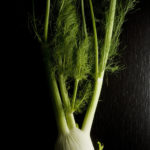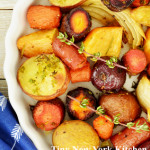Fennel is a member of the carrot family, though it is not a root vegetable. The base of its long stalk weaves together to form a thick and crisp bulb that grows above ground. Fennel’s leaves, seeds, and stems all have a sweet, faintly anise like flavor. The stems of fennel swell and overlap at the base of the plant to form a bulb with white to pale green ribbed layers that are similar to celery in appearance and texture. Light and feathery, the pretty green leaves slightly resemble fresh dill. Use them as a bed for steaming fish or in small amounts as a garnish.
Originating in the Mediterranean, the fennel bulb appears often in Italian and Scandinavian cuisines. It can be eaten raw, grilled, baked, braised, or sautéed. While grilling, you can toss a handful of dried or fresh fennel stems onto the charcoal to infuse meat or fish with a light anise flavor.
When selecting fennel choose fresh bulbs that are smooth and tightly layered with cracks or bruises. Fat, rounded bulbs with white and pale green color will tend to be more succulent than thin or yellow ones. Avoid any with wilted leaves or dried layers. Now available year-round, fennel is at its peak from late fall through winter. Grocers sometimes incorrectly liable fennel as sweet anise.
When storing, keep fennel bulbs in a perforated plastic bag in the refrigerator for up to 5 days. If kept too long, they will lose their flavor and toughen.
When preparing, remove the green stems and leaves, saving them to flavor or garnish other dishes such as soups or fish. Discard the outer layer of the bulb if it is tough and cut away any discolored areas. Cut the bulb in half lengthwise and remove the base of the core as it is thick and solid. Gently separate the layers with your hands and rinse well to remove any grit between them. Slice or cut as your recipe directs.
©Tiny New York Kitchen © 2021 All Rights Reserved
Eating well just got easier. Use one or more ingredients from each of the five categories. Stick with one international flavor profile. Find a sauce in your market’s global-foods section: ssamjang, chutney, hot sauce, salsa, pesto, chimichurri, romesco, aioli, tahini, or peanut sauce. Save money by using leftovers. Save time by using prechopped fresh vegetables.
CHOOSE A BASE INGREDIENT
1/2 Cup
Cooked Brown Rice, Quinoa, Millet, Bulgur, Farro, Barley, Whole Grain Pasta
CHOOSE A LEAN PROTEIN
3 To 4 Ounces
Cooked Meat, Poultry, Seafood, Legumes, Eggs, Tofu
CHOOSE VEGETABLES
1 To 2 Cups
Vary Colors And Textures
CHOOSE A SAUCE
1 To 3 Tablespoons
Sriracha, Harissa, Soy, Sweet Chili, Ssamjang, Chutney, Hot Sauce, Salsa, Pesto, Chimichurri, Romesco, Aioli, Tahini, Peanut Sauce
Bowl Ideas
Korean: Cooked noodles or rice, shredded carrot, sliced cucumber, sliced daikon radish, bean sprouts, sliced grilled beef, runny fried egg, ssamjang, kimchi
Middle Eastern: Cooked bulgur, roasted eggplant, roasted cauliflower, sautéed spinach, cooked chickpeas, grilled chicken, minted yogurt sauce, roasted pumpkin seeds, za’atar spice blend
Italian: Cooked faro, sautéed zucchini, sautéed kale, roasted red peppers, roasted cherry tomatoes, tuna, pesto, olives, marinated artichoke hearts, pine nuts
“Work With What You Got!”
©Tiny New York Kitchen © 2019 All Rights Reserved
This fall Tiny New York Kitchen celebrates sweet parsnips, earthy beets, and mild turnips. These root vegetables offer flavor, nutrition, and versatility.
Look for root vegetables that are firm to the touch with smooth, blemish-free skin. If there are any greens attached, make sure they look fresh, not wilted.
Before storing parsnips, beets, and turnips, remove any greens and brush off any dirt. Wrap in a damp paper towel, place in a plastic bag, and store in the refrigerator crisper; most roots will last up to two weeks.
Root vegetables absorb nutrients from the soil they grow in, including antioxidants, iron, and vitamins A, B, and C. They also provide fiber, which helps you feel fuller longer. To maximize your fiber intake, leave the skin on and give parsnips and carrots a good scrub instead.
Parsnips: These pale, carrot-like root vegetables are sweet and earthy. They can be roasted, sautéed, mashed, and puréed. Choose small to medium parsnips, since larger ones can be woody.
Beets: Beets can be red, golden, or striped. Whether roasted, boiled, or steamed, they’re slow to cook, but packaged precooked versions are also an option. You can even enjoy beets raw. Simply peel and grate or thinly slice.
Turnips: Creamy white with pinkish-purple tops, turnips turn mellow and tender when cooked. Try them roasted, sautéed, mashed, or added to soups and stews.
Greens: If you’re lucky, your beets and turnips will have greens attached. These edible, nutritious, and delicious greens should always be removed for storage, as they pull moisture from the root ends. Wash the greens and use to make pesto, or sauté with garlic and oil for a quick side dish or simple pasta.
“Work With What You Got!”
©Tiny New York Kitchen © 2018 All Rights Reserved
Pulling a tender, juicy roast chicken with crisp, golden brown skin out of the oven is so rewarding. For a simple side, roast a pan of in-season produce like spring onions, ramps, new potatoes or carrots during the last 20 minutes of cooking.
INGREDIENTS
1 Whole Chicken (4 Pound)
1 Teaspoon Sea Salt
1/2 Teaspoon Freshly Ground Pepper
Preheat oven to 425 degrees.
Remove neck and giblets from chicken. Trim off any excess fat from neck and tail end of chicken. Rinse bird with cool running water. Pat dry with paper towels, and season all over with salt and pepper.
Place chicken, breast side up, on a rack in a small-size roasting pan or a 9×13 inch-baking dish. Tuck wings back and behind bird to hold them in place. Roast, basting once or twice with pan juices, until skin is deep golden brown and juices run clear, about 1 1/2 hours.
An instant-read thermometer inserted in the thickest part of the thigh should read 165 degrees. Let chicken rest for 15 minutes and then carve.
To add fragrant flavor, stuff the cavity with a halved lemon or orange and a handful of fresh herbs like rosemary, thyme, and oregano.
Serve with an easy salad of greens topped with cherry tomatoes, mozzarella, and a drizzle of olive oil.
Serves 4
Prep Time: 20 Minutes
Cook Time: 90 Minutes
Total Time: 110 Minutes
“Work With What You Got!”
©Tiny New York Kitchen © 2018 All Rights Reserved
Use The Leaves
The leafy green stems of beets or radishes make a tasty side dish when sautéed with garlic and olive oil. Try blending carrot greens with olive oil, Parmesan cheese, and a squeeze of lemon for a tasty pesto.
Slice The Stems
Broccoli stalks are the perfect size for spiralizing and make a crunchy addition to salads.
Zest The Rind
Citrus peels are packed with sweetness. Their flavorful zest will elevate any marinade, vinaigrette, or dessert.
Vegetable Stock
And, of course, you can make homemade vegetable stock.
“Work With What You Got!”
©Tiny New York Kitchen © 2018 All Rights Reserved
The orange carrot we know and love today came originally from Holland, but up until the Middle Ages, all carrots were purple. Gardeners often delight in such oddities, but you will be very lucky to find any purple specimens available in stores or supermarkets.
Carrots contain large amounts of carotene and vitamin A, along with useful amounts of vitamins B3, C and E. When eaten raw, they also provide potassium, calcium, iron and zinc, but these are partly destroyed with cooking.
Almost all vegetables have a better flavor if they are grown organically, but this is particularly true of carrots. If possible, buy organic ones, or look for the young, pencil-thin carrots that still have their feathery tops attached. These young carrots can be eaten raw, or steamed for a few minutes. Older carrots should be unblemished and feel firm. Carrots should not be stored for too long, but they will keep for several days in a cool airy place or in the salad drawer of the refrigerator.
The age of carrots is a guide to how they should be prepared. The valuable nutrients lies either in or just beneath the skin, so if the carrots are young, simply scrub them. Medium-size carrots may need to be scraped with a knife before cooking them and large carrots will need to be scraped or peeled. Carrots can be cooked or eaten raw. To eat raw, they can be cut into julienne strips and tossed with a dressing, or grated into salads and coleslaw. They can bee cooked in almost any way you choose. As an accompaniment, cut them into julienne strips and braise in butter and cider. Roasted carrots are delicious, with a melt-in-the-mouth sweetness. Par-boil large ones first, but younger carrots can be quickly blanched or added direct to the pan with a joint of meat.
“Work With What You Got!”
© Victoria Hart Glavin Tiny New York Kitchen © 2017 All Rights Reserved
September
September is a wonderful time for enjoying the beautiful array at local farmers’ markets. September is a delightful time for gathering ingredients that will showcase fleeting flavors of summer. A walk among colorful baskets filled with fresh produce is incredibly inspiration.
Blazing scarlet tomatoes, sun-sweetened and fattened from their time on the vine, are joined by zesty green, bright yellow, and almost purple-colored varieties. Turn this beautiful rainbow into a final summer tomato salad by simply cutting thick slices of each colorful variety of tomato, and arranging them on a big platter. Drizzle the slices with olive oil and balsamic vinegar, sprinkle with a bit of sea salt, and finish the dish with finely minced basil.
Fill your shopping cart with crisp cucumbers, glossy purple or creamy white eggplant, pale green or buttery yellow summer squashes, string or wax beans, spicy jalapeno peppers, fragrant peaches, lush melons, sugary corn on the cob and great bunches of finely scented fresh herbs.
As September evenings grow quietly cooler, take pleasure in preparing dishes that feature these ingredients, such as nutmeg-scented roasted peaches, a delectable eggplant parmesan, velvety corn soup, garlic string beans or summer squash stuffed with ground lamb or turkey, breadcrumbs, fresh basil, oregano and parsley, cinnamon and bit of cheese. Cucumbers can be turned into simple refrigerator pickles, jalapeños can be roasted on the grill and packed away in the freezer, ensuring that a bit of summer will still be served as the season marches on.
There is also a hint of fall to be found at the farmers’ market. While all of the summer crops are still available to be savored, the new season is sneaking in. Freshly dug potatoes, dark purple plums, crisp early apples, succulent pears, Brussels sprouts, earthy mushrooms, carrots, cauliflower and kale will provide culinary creativity for weeks to come.
Cooking and eating with the seasons is the most excellent and efficient way to introduce high quality nutrients into the body. When we enjoy what nature has prepared for us, we are giving our bodies the gift of exceptionally luscious flavor, along with important healing properties. I can’t think of a better way to prepare a delicious life.
www.tinynewyorkkitchen.com
“Work With What You Got!”
© Victoria Hart Glavin Tiny New York Kitchen © 2016 All Rights Reserved
5 Ways To Use A Vegetable Peeler
The humble vegetable peeler has hidden talents.
Easily Peel Fruit: To peel soft fruits and vegetables, like tomatoes and peaches, you usually have to briefly dunk them into boiling water. Using a good vegetable peeler is so much easier and faster. Look for peelers with serrated blades for the best results and select not-too-ripe fruit.
Shaved Cheese: Give salads, pastas and roasted vegetables a restaurant-style finish by garnishing with generous amounts of shaved Parmesan or pecorino romano cheese.
Vegetable Pasta: Shave long strips of zucchini, carrots (even sweet potatoes and squash) to transform them into pasta substitutes. Serve raw or briefly steamed with your favorite sauce, or toss with a vinaigrette for a fresh and nutritious salad.
Spreadable Butter: Is there anything worse than trying to butter toast or bread with rock hard butter straight from the fridge? Use a vegetable peeler to scrape off thin and perfectly spreadable butter ribbons.
Chocolate Curls: Peel the edge of a slightly softened chunk of chocolate to create curls, or the flat surface of very cold chocolate to make shavings. Keep your creations in the freezer and use to garnish cakes, pies, puddings and seasonal fruit.
www.tinynewyorkkitchen.com
“Work With What You Got!”
© Victoria Hart Glavin Tiny New York Kitchen © 2016 All Rights Reserved
Everything From Apple Sauce To Tzimmes!
For a Sensational Seder you’ll want to have these traditional Passover dishes on hand.
Coconut Macaroons (You’ll Go Coco-Loco For Coconut Macaroons!)
Haroseth (For A Sweet Seder)
Matzo Ball Soup (Keep Your Eye On the Matzo Ball)
Potato Kugel (When Life Gives You Potatoes, Have Kugel)
Apple Sauce (Passover’s Special Sauce For Latkes & More)
Chopped Chicken Liver (What Am I? A Great Topper For Matzo!)
Kosher Passover Soups (A.K.A. Jewish Penicillin)
Karpas (That’s Parsley, For The Gentiles)
Matzo (You Gotsa Have Lotsa Matzo On Passover)
Root Vegetable Tzimmes (Get In Touch With Your Roots!)
Honey Glazed Carrots (Yummy)
Gefilte Fish (Just Like Your Grandmother Used To Make)
Kedem Concord Grape Juice (Tasty Enough For All Four Cups)
Raspberry Jelly Ring (If It’s Kosher, You Shoulda Put A Jelly Ring On It!)
Honey (Make A Nod To The Land Of Milk & Honey)
Beitzah (Don’t Forget The Eggs!)
Whole Kosher Brisket (Braise With Onions & Make Your Bubbe Proud)
Leg Of Lamb (Get A Leg Up On Seder Dinner)
Flourless Cake With Chocolate Glaze (Because 8 Days Without Cake Is A Long Time)
“Work With What You Got!”
© Victoria Hart Glavin Tiny New York Kitchen © 2016 All Rights Reserved















